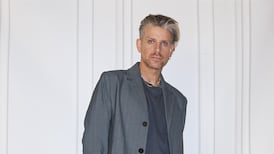The 2,000-year-old practice of yoga is being hijacked by fitness fanatics, exploited by commercial interests, and taught by people who don't understand it, argues instructor Jennifer Keegan
The room is pristine white, with swirls of incense moving across polished floorboards. There is a sense of urgency as lithe figures in body-hugging tops move through rigorous postures, sweating and breathing heavily in tune to precise instructions. The windows are steamed up and the room is jammed. The scene looks to be straight out of some hip LA gymnasium. But this isn't California, it is an Astanga yoga class in Dublin.
Yoga, especially the more vigorous forms, has become a fitness fad, a fashion statement and a favourite pursuit of the beautiful people. We know this because we see it in the press: Gucci's new $850 yoga mat, Christy Turlington with her range of designer yoga shoes, and a skinny Geri Halliwell in Warrior pose. It is the hip new way to get fit, toned and become desirable, or so the lifestyle magazines are telling us.
But, wait a minute, hasn't yoga been around for a couple of thousand years? And isn't it supposed to be a profound, ego-free, spiritual practice that liberates the individual from confusion and pain? In the traditional Indian practice, the physical benefit is just one aspect of yoga. Essentially, yoga is about bringing the body to a state of good health, as a vehicle for meditation and, ultimately, self-realisation. But in the western world we hijack the physical aspects of yoga practice that suit us, and ignore the philosophical and spiritual ones.
"Yoga has always been a practice of the mind," says Marlene ffrench Mullen, who has been teaching yoga for 16 years. "It has its own system of philosophy and uses a very specific method to raise levels of awareness and explore the potential of the mind."
Yoga, remember, urges us to live in peace and harmony with our fellow human beings; the word yoga, after all, is Sanskrit for union. And yet the different forms or brands of yoga are often pitted against each other. The Iyengar followers despise the body-beautiful focus of some Astanga practitioners, while Astangis think that Hatha and Iyengar yogis don't take their bodies seriously enough, and waste too much time correcting their alignment and playing with props.
Bikram yoga, another hardcore form, is practised in sauna-like conditions in front of mirrors. "To be honest, it's a kind of yoga-aerobics for most people," says Rachel Gore, a Bikram yoga teacher currently training abroad in another form of yoga. "At least 60 per cent of my students are coming to Bikram classes for weight-loss and detox purposes. They are not interested in the spiritual aspect, or what they would see as the mumbo jumbo side of yoga. They aren't open-minded enough to see all the other possibilities."
Back in another yoga class people huff and puff and coerce themselves into advanced postures, their faces red and contorted. Many of them seem to be unprepared for the postures. "People want instant results," Gore says. "They have no time to wait, they want it all now. They might be high achievers in their lives and they want the same from their yoga. Perhaps it's the culture that we live in. We are driven by ego, guilt and anxiety. People can't accept themselves as they are, so they punish themselves with gruelling rituals."
"I know," she adds, "because I used to be like that myself. I started with Astanga yoga and I became obsessed with it; it was addictive, and I felt that if I killed myself working really hard at it, I'd be okay as a person. But in fact I totally burnt myself out, and that's when the real learning about yoga began."
Astanga is measured in levels, that is, primary series, secondary series, and so on. In the west the practitioner is usually encouraged to feel that there is always another level to aim towards, so it is a challenge to feel content with your body at any particular time. "There's also a showy scene and a kudos that goes with it," Gore explains. "So it's inevitable that this will generate competition and a desire to push aggressively. Not that it isn't possible to do or teach Astanga softly or with sensitivity of course," she adds.
Having spent time studying Astanga yoga in India, Marlene ffrench Mullen explains that there is a different attitude there to the teaching of yoga. "Even strong teachers such as Pattabhi Jois (the father of Astanga) won't let you practise poses you're not ready for," she says. "His famous line is 'practise . . . all is coming'." In other words, be patient. "Perhaps it's just that we have a different mindset here, and that teachers are responding to what the public wants."
But not all teachers. Orla Punch used to teach both Astanga and Iyengar yoga, but gave up the former when the Iyengar Institute insisted that its teachers only teach their method. "I had to make a decision between the two," Punch says. "I loved Astanga. It was great fun, and being madly fashionable, there was loads of money in it. But I felt it was very flighty, and you weren't challenged to involve your mind really, because of the repetition of the sequence. So I started to question that.
"I felt that Iyengar was a more intelligent form of yoga and that it was physically more beneficial. I mean, at the end of the day, why would you need to turn yourself inside out. That kind of thing feeds the ego; the more weird and wonderful shapes you can make, the greater you think you are, but it's not about that. I eventually decided I wanted to teach a form of yoga that I believed in. But my income has dropped hugely as a result of that decision."
There is money in yoga, though, provided you have a business head and are not a purist. The brashest of the international commercial "gurus" is Bikram Choudhury, who is worth some €6.5 million and has a penchant for Rolls-Royces. According to Rachel Gore, who studied with him: "He is very Hollywood; aggressive, rigid and obsessed with money." Sparks flew when he announced he was going to franchise his form of yoga, Starbucks-style, as well as trademark his sequence of postures and his 600 studios, leading to fights and lawsuits.
Meanwhile, there has been a huge increase of new teachers in Dublin. "There is a glut in the market," Punch says. "People used to want to be air-hostesses, now they all want to be yoga teachers. I don't know why, because it's hardly glamorous and there's no money in it. I worry about the lack of experience out there."
It seems that the lack of professional standards in yoga - it is possible to do a one-week intensive course and become a teacher - might also be a significant problem. Being a good and safe teacher has nothing to do with being able to bend yourself inside out. Traditionally it took years of practice and an understanding of the philosophy and psychology.
According to Marlene ffrench Mullen, who trains teachers, "becoming a teacher requires a minimum of three to four years solid training. The knowledge only reveals itself gradually and slowly," she adds. "There are no quick fixes when it comes to yoga." In the meantime, gym instructors will continue to do weekend yoga courses and call themselves qualified; many of them are teaching some form of aerobics with yoga moves thrown in in a bid to attract customers.
With all the conflicting messages out there, how can a prospective yoga student find the right teacher? They may just see the great looking poster or the flashy website, and many of the best teachers don't have either of these. And because someone has good marketing ability doesn't mean that teaching yoga is their inspiration. It's the motivation behind the teaching that is perhaps most relevant - are they in it for the cash (or for the kudos maybe, yoga being hip and all), or are they teaching because they have a real passion for yoga and for passing on their often hard-gained knowledge?
For novices, of course, it is better to get out there and do something physical, regardless of what it is, in preference to slouching on the couch watching too much telly. And by working on the physical part of yoga, sometimes the mind becomes curious and the practitioner will gradually open up to the other aspects and discover that yoga is not a faddish practice, neither is it a hippy-dippy means of escape from this world. Instead, it is a skilful way of travelling to the very heart of life.
The yoga tribes
HATHA YOGA Classic Indian yoga upon which most other forms are based. It implies the union of opposite tendencies in the body and mind to create balance. It can be practised gently to fairly strongly and frequently includes "pranayama" or breathwork.
IYENGAR YOGA Based on the teachings of BKS Iyengar, this form of yoga is an effective and safe way to develop a good posture practice. With a valuable focus on precision and re-alignment, it often makes use of props, which can mean that it sometimes lacks flow.
ASTANGA YOGA A fast-paced physical yoga that uses a specific form of breathing called "ujjayi". There is constant flowing movement linking one posture to the next. Requires stamina.
DYNAMIC YOGA Incorporates the flow and breathwork of Astanga with the precision and alignment of Iyengar. The pace is slower than Astanga and the postures are held in order to develop awareness and sensitivity.
POWER YOGA A western offshoot of the Astanga Vinyasa yoga practice. The original sequences are adapted, sometimes to make it easier or sometimes to make it more challenging.
BIKRAM YOGA Involves 26 postures repeatedly practised in 105 degree temperatures, in front of mirrors. You sweat for your karmic gold stars.
DOG YOGA Also known as Doga: the practice of yoga with your pooch. Calm doggie, calm master.
DISCO YOGA/YOGABEATS The yoga shuffle to your favourite tunes. A sort of mix between yoga, circuit training and boogie.
LAUGHTER YOGA Chortle your way to enlightenment. Their catchphrase is "fake it, fake it till you can make it". Usually practised in large parks.
YOGA-BOX Another fashionable fusion - rather an interesting one given that yoga advocates non-violence.
How to find a teacher
Finding the right teacher is an individual thing. You may have to try more than one to find the right fit.
Choose a type of yoga that will suit your temperament and your physical ability. Ask a prospective teacher if you can come for just one class before signing up to a course, to see if their style of yoga and of teaching suits you.
Ask a prospective teacher how long they have been doing/teaching yoga. They should have been practising for a minimum of three years. Ask whom they studied with, and over what period of time. They should ideally have spent a minimum of two years studying a single technique.
Teachers should be attending classes and doing workshops with senior teachers. Ask if they continue to practise yoga themselves. Anyone who doesn't practise yoga regularly should not be teaching.
Do they sound like they are interested in their subject and interested in teaching you? Do you sense that they are passionate about what they teach.
For tips on finding a teacher, see http:/yogaholidays.net/magazine/choosing.htm, and www.yoga-ireland.com/classes for a list of teachers.










